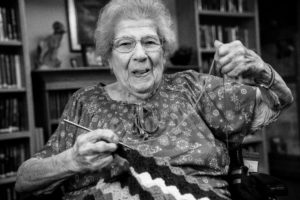In this post, I put on my cultural critic hat, and it’s a little (a lot) longer than usual. So pop some popcorn, kick back, and enjoy a discussion of aging in popular culture!
For two or three years quite a while ago, the Fox crime show Bones was one of my favorites. Early in my grad school days, a roommate and I happened across the premier—and got hooked. Watching this somewhat silly, always somewhat gross, and yet somehow heartfelt (at least in those days) show became one of our weekly rituals. We’d settle on the couch and observe FBI Agent Sealy Booth, forensic anthropologist Temperance Brennan, and their team of scientists as they caught the Murderer of the Week. Then we’d discuss (okay, nitpick) the show. After I moved across the country to pursue further studies, I kept watching the show, albeit on my own. At some point, though—I can’t remember exactly when—the silliness and the grossness overtook the heartfelt relationships between the characters and the compelling storylines, and I stopped watching.
All this is a long way of telling you that, thanks to the wonders of streaming video, I’ve been catching up on all the episodes of Bones I never saw. I’m now on the final season, and two episodes jumped out at me because of their contrasting portrayals of aging. I’m sorry to say that, at least in my opinion, Bones never regained its early charm. Still, precisely because of its general frivolity, I think it’s a good idea to talk about how a show like Bones portrays aging. In its final season, the show offers two quite different visions of growing older in America and, perhaps inadvertently, offers a fascinating comment on the options available to us as we age.
NOTE: Since this show finished airing about a year ago, I will be discussing the episodes in detail, including endings. Also, this is a murder show, and very bad things happen to seniors.
The first episode I want to talk about actually aired second. It’s called “The Scare in the Score” and was episode 7 in the season. This episode builds to a dramatic climax centering on Booth and Brennan’s family (they’re married and have two kids by this point). In the beginning, however, they set out to solve the murder of Margaret Kwan, an elderly woman whose body is found in the woods. As they research the victim’s background, the team discovers that Margaret was a shut-in who lived entirely alone and had few contacts with the outside world. In fact, her most meaningful relationship was with the delivery man who brought the items she ordered from the home shopping channel. (He’s also the episode’s second victim and his murder sets in motion the main plot.)
The vision of aging in this episode is bleak indeed. Margaret lives alone and has no family or friends except for her delivery man. And to make matters worse, her death isn’t even the point. It turns out that she was tortured and killed because the delivery man had information on Booth and Brennan that the murderer wanted, and hurting her was a way to get to him. We don’t even know if it worked, because the delivery man was also tortured and killed and the episode never tells us whether he caved before Margaret died. Plot holes aside, this is a distressingly instrumental but also poignant portrayal of an older adult’s death. In the context of the story, Margaret’s death matters only in the sense that it leads the team to the delivery man, the “more important” victim whose death advances the series’ overall plot. But whether or not the writers intended to do so, they made a point about aging. Margaret’s death reminds us (in a very grizzly way) that many seniors live alone and that without connection, aging does indeed become a sad, lonely time of life.
The second episode I’ll discuss shows that it doesn’t have to be this way. Season 12, Episode 3, “The New Tricks in the Old Dog,” is set in a retirement community. So before I go on, I need to get my rant out of the way. The show calls it a “retirement home.” No one in the real-life industry calls it a “retirement home.” It is a retirement community, or maybe a senior living community, or just, you know, apartments for older adults. The point is that it’s a place where people go because they want to live around other people, not because they need to be put away, a point which the episode otherwise seems to recognize. Also, the one and only non-director staff member who makes an appearance is called an “orderly,” which makes no sense. None. That’s a hospital word (I guess? Do hospitals have orderlies anymore?). This doesn’t seem to be an Assisted Living community, so what does this guy even do? And why does he wear white scrubs? Why didn’t the writers visit an actual retirement community to see what kind of staff they have? I have so many questions about the orderly!
Ahem. Anyway, the victim, James, is a resident of said retirement community. Over the course of their investigation, Brennan and Booth discover that he had a romantic relationship with Barbara, one of the other residents. She is wealthy, and it turns out that James and a third resident, Rufus, had a partnership in which they seduced wealthy women and scammed them out of their savings. But James had fallen in love with Barbara, so much in love that he sold his osteoporosis medication online so he could buy her a wedding ring and hired a private investigator to find her long-lost daughter. Rufus isn’t happy, but he’s not the murderer. The murderer is yet another resident, a man named Red, an ex-serviceman who got very upset when he discovered that James had lied about being in the military. He hit James with his cane and, because James hadn’t been taking his osteoporosis medication and was very vulnerable to blows, James died of his injuries even though Red did not intend to kill him.
“Homes” and “orderlies” aside, I thought this episode had some interesting things to say about aging in community. For the most part, the residents weren’t played for laughs. They were people who happened to be older, and they developed relationships with each other, good and bad, that were unique to their life stage but not shown to be weird or gross. The characters’ bad actions are neither downplayed nor overemphasized because of their age, and age itself isn’t central to the murder. Like so many murderers on this show, Red uses the weapon that’s closest to hand—which happens to be his cane. Similarly, James sells osteoporosis medication because that’s what he has to sell. And he sells it because he has fallen in love, highlighting how we continue to develop new bonds with each other even toward the ends of our lives. His love for Barbara may have started out as a scam, but it turned into something real on both sides. Unlike Margaret Kwan from “The Scare in the Score,” James is surrounded by friends who miss him, and viewers get the feeling that his death is more than a plot device—it’s important and sad because every premature death is important and sad.
Side by side, these two episodes of Bones show two extremes of aging. Margaret has no connections and James has plenty of them. Though I’m sure they wouldn’t put it this way, the writers of Bones offer in the last season what amounts to an advertisement for living in community as we age. It’s interesting to find this in a show that isn’t about aging in any meaningful way, but I think it’s a good sign. It’s important for all of us to think about what we want as we grow older and to consider how we as a society approach the growing number of older adults in our cities, states, and countries. Pop culture can help us do that—even silly TV shows like Bones.


 Virginia Hull loves to crochet. The Immanuel Skilled Care Center resident always has a project in progress, and she frequently carries her yarn and hook with her. On a couple of occasions, I’ve run into her just as she’s about to leave for or just getting home from a shopping trip to the hobby store to buy more yarn.
Virginia Hull loves to crochet. The Immanuel Skilled Care Center resident always has a project in progress, and she frequently carries her yarn and hook with her. On a couple of occasions, I’ve run into her just as she’s about to leave for or just getting home from a shopping trip to the hobby store to buy more yarn.